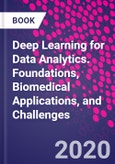Deep learning, a branch of Artificial Intelligence and machine learning, has led to new approaches to solving problems in a variety of domains including data science, data analytics and biomedical engineering. Deep Learning for Data Analytics: Foundations, Biomedical Applications and Challenges provides readers with a focused approach for the design and implementation of deep learning concepts using data analytics techniques in large scale environments. Deep learning algorithms are based on artificial neural network models to cascade multiple layers of nonlinear processing, which aids in feature extraction and learning in supervised and unsupervised ways, including classification and pattern analysis. Deep learning transforms data through a cascade of layers, helping systems analyze and process complex data sets. Deep learning algorithms extract high level complex data and process these complex sets to relatively simpler ideas formulated in the preceding level of the hierarchy. The authors of this book focus on suitable data analytics methods to solve complex real world problems such as medical image recognition, biomedical engineering, and object tracking using deep learning methodologies. The book provides a pragmatic direction for researchers who wish to analyze large volumes of data for business, engineering, and biomedical applications. Deep learning architectures including deep neural networks, recurrent neural networks, and deep belief networks can be used to help resolve problems in applications such as natural language processing, speech recognition, computer vision, bioinoformatics, audio recognition, drug design, and medical image analysis.
Please Note: This is an On Demand product, delivery may take up to 11 working days after payment has been received.
Table of Contents
Section I Deep Learning Basics and Mathematical Background 1. Introduction to Deep Learning 2. Probability and information Theory 3. Deep Learning Basics 4. Deep Architectures 5. Deep Auto-Encoders 6. Multilayer Perceptron 7. Artificial Neural Network 8. Deep Neural Network 9. Deep Belief Network 10. Recurrent Neural Networks 11. Convolutional Neural Networks 12. Restricted Boltzmann Machines
Section II Deep Learning in Data Science 13. Data Analytics Basics 14. Enterprise Data Science 15. Predictive Analysis 16. Scalability of deep learning methods 17. Statistical learning for mining and analysis of big data 18. Computational Intelligence Methodology for Data Science 19. Optimization for deep learning (e.g. model structure optimization, large-scale optimization, hyper-parameter optimization, etc) 20. Feature selection using deep learning 21. Novel methodologies using deep learning for classification, detection and segmentation
Section III Deep Learning in Engineering Applications 22. Deep Learning for Pattern Recognition 23. Deep Learning for Biomedical Engineering 24. Deep Learning for Image Processing 25. Deep Learning for Image Classification 26. Deep Learning for Medical Image Recognition 27. Deep learning for Remote Sensing image processing 28. Deep Learning for Image and Video Retrieval 29. Deep Learning for Visual Saliency 30. Deep Learning for Visual Understanding 31. Deep Learning for Visual Tracking 32. Deep Learning for Object Segmentation and Shape Models 33. Deep Learning for Object Detection and Recognition 34. Deep Learning for Human Actions Recognition 35. Deep Learning for Facial Recognition 36. Deep Learning for Scene Understanding 37. Deep Learning for Internet of Things 38. Deep Learning for Big Data Analytics 39. Deep Learning for Clinical and Health Informatics 40. Deep Learning foe Sentiment Analysis
Authors
Himansu Das Assistant Professor, Kalinga Institute of Industrial Technology University, Bhubaneswar, Odisha, India. Himansu Das is working as an as Assistant Professor in the School of Computer Engineering, KIIT University, Bhubaneswar, Odisha, India. He has received his B. Tech and M. Tech degree from Biju Pattnaik University of Technology (BPUT), Odisha, India. He has published several research papers in various international journals and conferences. He has also edited several books of international repute. He is associated with different international bodies as Editorial/Reviewer board member of various journals and conferences. He is a proficient in the field of Computer Science Engineering and served as an organizing chair, publicity chair and act as member of program committees of many national and international conferences. He is also associated with various educational and research societies like IACSIT, ISTE, UACEE, CSI, IET, IAENG, ISCA etc., His research interest includes Grid Computing, Cloud Computing, and Machine Learning. He has also 10 years of teaching and research experience in different engineering colleges. Chittaranjan Pradhan School of Computer Engineering, KIIT University, India. Chittaranjan Pradhan is working at School of Computer Engineering, KIIT University, India. He obtained his Bachelors, Masters and PhD degree in Computer Science & Engineering stream. His research are includes Information Security, Image Processing, Data Analytics and Multimedia Systems. Dr. Pradhan has published more than 40 articles in the national and international journals and conferences. Also, he has been associated to a number of events organized at national and international level. He is also associated with various educational and research societies like IACSIT, ISTE, UACEE, CSI, IET, IAENG, ISCA etc. He has also experience of more than 10 years in teaching and research activities. Nilanjan Dey Associate Professor, Department of Computer Science and Engineering, Techno International New Town, Kolkata, India.Nilanjan Dey is an Associate Professor in the Department of Computer Science and Engineering, Techno International New Town, Kolkata, India. He is a visiting fellow of the University of Reading, UK. He also holds a position of Adjunct Professor at Ton Duc Thang University, Ho Chi Minh City, Vietnam. Previously, he held an honorary position of Visiting Scientist at Global Biomedical Technologies Inc., CA, USA (2012-2015). He was awarded his PhD from Jadavpur University in 2015. He is the Editor-in-Chief of the International Journal of Ambient Computing and Intelligence , IGI Global, USA. He is the Series Co-Editor of Springer Tracts in Nature-Inspired Computing (SpringerNature), Data-Intensive Research(SpringerNature), Advances in Ubiquitous Sensing Applications for Healthcare (Elsevier). He was an associate editor of IET Image Processing and editorial board member of Complex & Intelligent Systems, Springer Nature. He is an editorial board member of Applied Soft Computing, Elsevier. He is having 35 authored books and over 300 publications in the area of medical imaging, machine learning, computer aided diagnosis, data mining, etc. He is the Fellow of IETE and Senior member of IEEE.








